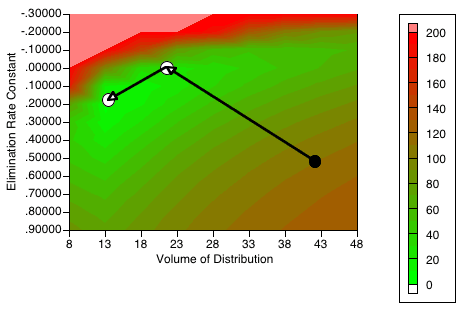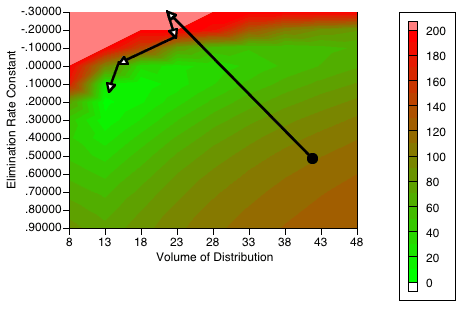
Equation 28.5.1 Equation for the next Parameter Value according to the Gauss-Newton Method - One Parameter
return to the Course index
previous | next

Equation 28.5.1 Equation for the next Parameter Value according to the Gauss-Newton Method - One Parameter

Equation 28.5.2 Equation for the next Parameter Value according to the Gauss-Newton Method - Multiple Parameters
The nonlinear regression program usually performs the single and double differentiations numerically. (For special problems it would be useful to analytically determine equations for these differentiations but this is not generally performed). Numerical differentiation requires the calculation of the WSS with two values of each parameter. The relative stepsize between these values is represented by dT in Boomer. The default value is usually satisfactory. Each pass through the equations above provides a single iteration, hopefully getting closer to the global minimum with each iteration. The program needs a criteria to decide when it has converged on the solution and it is time to stop. This convergence criteria, dC, can be expressed as either the smallest fractional change in WSS or in the change in the parameter values.
Advantages

Figure 28.5.1 Contour map of kel versus V showing probable Path of Damping-Gauss-Newton Method

Equation 28.5.3 Equation for Next Parameter value using Marquardt's Method
The Marquardt equation is similar to the Gauss-Newton equation above with the addition of the µI term. This term has the effect of allowing the method to act like the steepest descent method further from the global minimum where it is good and like the Gauss-Newton method closer to the answer where this method is better.

Figure 28.5.2 Contour map of kel versus V showing probable Path of Marquardt Method
All of these Gauss-Newton methods can be quite efficient but the calculations are involved and they can get lost or cause numerical instability. The Damping-Gauss-Newton and the Marquardt methods can be useful and are included in a number of nonlinear regression methods.
Material on this website should be used for Educational or Self-Study Purposes Only
Copyright © 2001 - 2025 David W. A. Bourne (david@boomer.org)
 |
The Book Pharmacokinetics This Course in ePub format |
 |